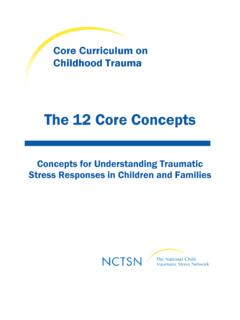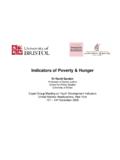Transcription of THE IMPACT OF FAMILY INVOLVEMENT ON THE EDUCATION …
1 THE IMPACT OF FAMILY INVOLVEMENT ON THE EDUCATION OF CHILDREN AGES 3 TO 8 A Focus on Literacy and Math Achievement Outcomes and Social-Emotional SkillsFrances L. Van Voorhis Michelle F. Maier Joyce L. EpsteinChrishana M. LloydOctober 2013 The IMPACT of FAMILY INVOLVEMENT on the EDUCATION of Children Ages 3 to 8 A Focus on Literacy and Math Achievement Outcomes and Social-Emotional Skills Frances L. Van Voorhis (Center on school , FAMILY , and Community Partnerships at Johns Hopkins University) Michelle F. Maier (MDRC) Joyce L. Epstein (Center on school , FAMILY , and Community Partnerships at Johns Hopkins University) Chrishana M. Lloyd (MDRC) with Therese Leung (MDRC) October 2013 This literature review is being funded through a grant from the Heising-Simons Foundation under Grant Number 2013-30.
2 Dissemination of MDRC publications is supported by the following funders that help finance MDRC s public policy outreach and expanding efforts to communicate the results and implica-tions of our work to policymakers, practitioners, and others: The Annie E. Casey Foundation, The George Gund Foundation, Sandler Foundation, and The Starr Foundation. In addition, earnings from the MDRC Endowment help sustain our dissemination efforts. Contrib-utors to the MDRC Endowment include Alcoa Foundation, The Ambrose Monell Foundation, Anheuser-Busch Foundation, Bristol-Myers Squibb Foundation, Charles Stewart Mott Founda-tion, Ford Foundation, The George Gund Foundation, The Grable Foundation, The Lizabeth and Frank Newman Charitable Foundation, The New York Times Company Foundation, Jan Nichol-son, Paul H.
3 O Neill Charitable Foundation, John S. Reed, Sandler Foundation, and The Stupski FAMILY Fund, as well as other individual contributors. The findings and conclusions in this report do not necessarily represent the official positions or policies of the funders. For information about MDRC and copies of our publications, see our Web site: Copyright 2013 by MDRC . All rights reserved. iii Overview This report summarizes research conducted primarily over the past 10 years on how families INVOLVEMENT in children s learning and development through activities at home and at school affects the literacy, mathematics, and social-emotional skills of children ages 3 to 8. A total of 95 studies of FAMILY INVOLVEMENT are reviewed. These include both descriptive, nonintervention studies of the actions families take at home and at school and intervention studies of practices that guide families to conduct activities that strengthen young children s literacy and math learning.
4 The FAMILY INVOLVEMENT research studies are divided into four categories: Learning activities at home, including those that parents engage in to promote their child s literacy and/or math skills outside school FAMILY INVOLVEMENT at school , including the actions and interactions that families have while in the school building school outreach to engage families, including the strategies that schools and teachers use to engage families and make them feel welcome Supportive parenting activities, including the nature and quality of the parent-child rela-tionship and home environment, rule-setting, and caring behaviors Key Findings FAMILY INVOLVEMENT is important for young children s literacy and math skills. The ma-jority of studies, including some randomized control trials (RCTs), demonstrate this positive link.
5 A few studies show positive relations with social-emotional skills. The weakest asso-ciation was between FAMILY INVOLVEMENT at school and children s outcomes. Parents from diverse backgrounds, when given direction, can become more engaged with their children. And when parents are more engaged, children tend to do better. This review also provides recommendations for additional lines of inquiry and implica-tions to guide next steps in both research and practice. While there is still more to learn about how to connect with and support caretakers efforts to promote children s learning, what we already know from extant research can help guide this process. More children attend preschool and all-day kindergarten than ever before, and educators are being urged by federal, state, and local institutions to use research-based or evidence-based ap-proaches to improve their work with families and families INVOLVEMENT with their children and the school .
6 This review strengthens the belief that interventions to boost FAMILY INVOLVEMENT may be a critical piece when trying to support children s early learning. v Contents Overview iii List of Exhibits vii Preface ix Acknowledgments xi Executive Summary ES-1 Chapter 1 Introduction 1 2 FAMILY INVOLVEMENT in Reading and Literacy Activities and Results for Children s Literacy Achievement and Social-Emotional Skills 7 3 FAMILY INVOLVEMENT in Math Activities and Results for Children s Math Achievement and Social-Emotional Skills 51 4 Summary, Reflections, and Recommendations 75 Appendix A Studies of FAMILY INVOLVEMENT in Literacy Activities and Math Activities and Social-Emotional Outcomes 87 B Examples from the Field: FAMILY INVOLVEMENT Activities with Young Children 163 C Glossary 181 References General References 187 References for Chapter 2: Reading and Literacy Activities 191 References for Chapter 3.
7 Math Activities 198 vii List of Exhibits Table Description of Journal Articles for Literacy and Math Reviews 6 Studies of FAMILY INVOLVEMENT in Literacy Activities and Literacy and Social-Emotional Outcomes 89 Studies of FAMILY INVOLVEMENT in Math Activities and Math and Social-Emotional Outcomes 127 Examples from the Field from Preschool to Elementary school : FAMILY INVOLVEMENT Activities of Reading with Young Children 169 Examples from the Field from Preschool to Elementary school : FAMILY INVOLVEMENT Activities of Math with Young Children 173 Examples from the Field from Preschool: Transition Activities with Young Children and Families 177 Box Feature Study: FAMILY INVOLVEMENT in Reading Activities at Home 13 Feature Study: Effects of Parent Intervention on Play and Learning Strategies (PALS) on Achievement and Social-Emotional Skills 16 Feature Studies: Parent-Child Conversations at Home 18 Feature Study: Multiple Measures of FAMILY INVOLVEMENT in Learning Activities at Home Versus Other Types of FAMILY INVOLVEMENT 21 Feature Study: Effects of FAMILY INVOLVEMENT at Home on Learning and Behavior 22 Feature Study: Effects of FAMILY INVOLVEMENT at school Over Time 28 Feature Study: Composite Measure of Parental INVOLVEMENT and Children s Achievement and Social-Emotional Skills 39 Feature Study: Intervention on Supportive Parenting and Achievement Outcomes 43 Feature Study: Change in Supportive Parenting and Results for Children s Achievement and Social-Economical Skills 45 Feature Study.
8 Intervention to Increase Parent INVOLVEMENT in Math Activities at Home 55 Feature Study: Intervention to Increase Parent INVOLVEMENT in General Learning Activities at Home 58 viii Box Feature Study: Nonintervention Exploration of Composite Measures of Parental INVOLVEMENT and Children s Learning and Behavior 60 Reading and Literary-Related Activities Engaged in by Children and Families 84 Math-Related Activities Engaged in by Children and Families 85 ix Preface In recent years, large investments have been made in the early childhood field with the goal of positively affecting young children s outcomes through two areas of inquiry: (1) parenting and home visiting and (2) early childhood care and EDUCATION . This commitment is underscored by President Obama s Early Learning Initiative, with its focus on a continuum of high-quality early learning for every child in America from birth to age 5 and its aim of leveling the playing field for children from lower-income families.
9 The FAMILY INVOLVEMENT research that is summarized in this report is firmly situated at the nexus of these two important areas of work, connecting what happens in the home with what happens in the school while keeping the child and positive child development as the primary focus. Given this context and the increased expectation that EDUCATION systems use research-based or evidence-based approaches in their work with families, the connection between home and school and how best to support it is likely a critical piece of the puzzle of how to comprehensively promote children s early learning. This report on almost 100 FAMILY INVOLVEMENT research studies focusing on the literacy, math, and socio-emotional skills of children ages 3 to 8 is a timely contribution to the field.
10 It presents the most rigorous empirical work that has been conducted, primarily over the past 10 years. The review finds that parents from diverse backgrounds, when given direction, can increase their INVOLVEMENT with their children s learning at home and at school and that, when parents are more involved and more engaged, children tend to do better academically and socially. More importantly, this review makes explicit recommendations for further lines of inquiry and offers several implications to guide next steps in both research and practice. While there is still much more to learn about how to connect with and support families efforts to promote children s learning across the home and school contexts most effectively, this report is a much-needed first step.












